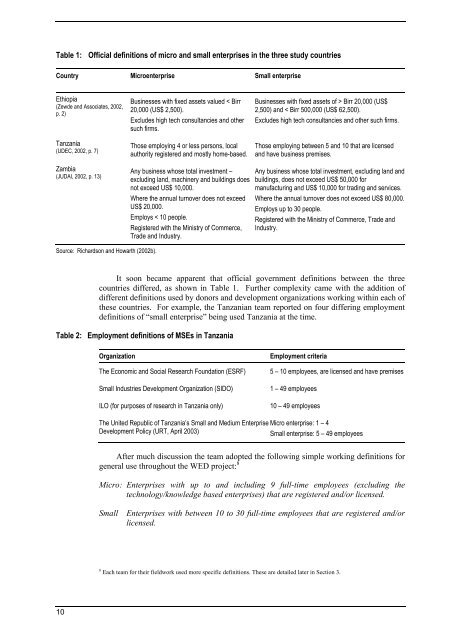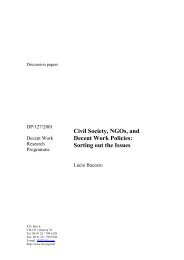The Challenges of Growing Small Businesses - International Labour ...
The Challenges of Growing Small Businesses - International Labour ...
The Challenges of Growing Small Businesses - International Labour ...
You also want an ePaper? Increase the reach of your titles
YUMPU automatically turns print PDFs into web optimized ePapers that Google loves.
Table 1: Official definitions <strong>of</strong> micro and small enterprises in the three study countries<br />
Country Microenterprise <strong>Small</strong> enterprise<br />
Ethiopia<br />
(Zewde and Associates, 2002,<br />
p. 2)<br />
Tanzania<br />
(UDEC, 2002, p. 7)<br />
<strong>Businesses</strong> with fixed assets valued < Birr<br />
20,000 (US$ 2,500).<br />
Excludes high tech consultancies and other<br />
such firms.<br />
Those employing 4 or less persons, local<br />
authority registered and mostly home-based.<br />
<strong>Businesses</strong> with fixed assets <strong>of</strong> > Birr 20,000 (US$<br />
2,500) and < Birr 500,000 (US$ 62,500).<br />
Excludes high tech consultancies and other such firms.<br />
Those employing between 5 and 10 that are licensed<br />
and have business premises.<br />
Zambia<br />
(JUDAI, 2002, p. 13)<br />
Any business whose total investment –<br />
excluding land, machinery and buildings does<br />
not exceed US$ 10,000.<br />
Where the annual turnover does not exceed<br />
US$ 20,000.<br />
Employs < 10 people.<br />
Registered with the Ministry <strong>of</strong> Commerce,<br />
Trade and Industry.<br />
Any business whose total investment, excluding land and<br />
buildings, does not exceed US$ 50,000 for<br />
manufacturing and US$ 10,000 for trading and services.<br />
Where the annual turnover does not exceed US$ 80,000.<br />
Employs up to 30 people.<br />
Registered with the Ministry <strong>of</strong> Commerce, Trade and<br />
Industry.<br />
Source: Richardson and Howarth (2002b).<br />
It soon became apparent that <strong>of</strong>ficial government definitions between the three<br />
countries differed, as shown in Table 1. Further complexity came with the addition <strong>of</strong><br />
different definitions used by donors and development organizations working within each <strong>of</strong><br />
these countries. For example, the Tanzanian team reported on four differing employment<br />
definitions <strong>of</strong> “small enterprise” being used Tanzania at the time.<br />
Table 2: Employment definitions <strong>of</strong> MSEs in Tanzania<br />
Organization<br />
<strong>The</strong> Economic and Social Research Foundation (ESRF)<br />
<strong>Small</strong> Industries Development Organization (SIDO)<br />
ILO (for purposes <strong>of</strong> research in Tanzania only)<br />
Employment criteria<br />
5 – 10 employees, are licensed and have premises<br />
1 – 49 employees<br />
10 – 49 employees<br />
<strong>The</strong> United Republic <strong>of</strong> Tanzania’s <strong>Small</strong> and Medium Enterprise Micro enterprise: 1 – 4<br />
Development Policy (URT, April 2003)<br />
<strong>Small</strong> enterprise: 5 – 49 employees<br />
After much discussion the team adopted the following simple working definitions for<br />
general use throughout the WED project: 8<br />
Micro: Enterprises with up to and including 9 full-time employees (excluding the<br />
technology/knowledge based enterprises) that are registered and/or licensed.<br />
<strong>Small</strong> Enterprises with between 10 to 30 full-time employees that are registered and/or<br />
licensed.<br />
8 Each team for their fieldwork used more specific definitions. <strong>The</strong>se are detailed later in Section 3.<br />
10
















